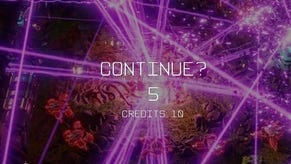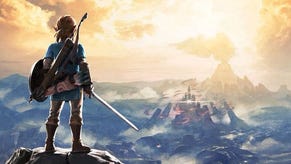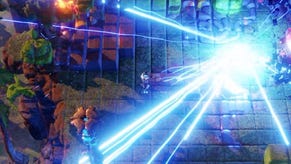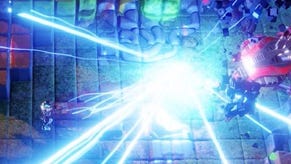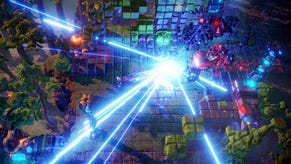'The bug isn't good enough'
How an arcade legend returned to the genre he invented.
Eugene Jarvis is talking a mile a minute, standing on the show floor at the PlayStation Experience in the unnatural and on-brand blue light within Anaheim's Convention Centre while overlooking his first foray into arcade shooters in well over 20 years, Housemarque's Nex Machina. He's already been talking for 30 minutes before I remember to hit the record button on my dictaphone, our animated chat about Donald Cammell's twisted sci-fi horror film Demon Seed while Jarvis waxed lyrical over the film's shape-shifting robo-cock lost to the ether.
It's probably for the best, all told, though it goes some way to illustrate some of the schlock that gives Jarvis' games their heart, and that have lent them an enduring appeal. He's the godfather of a certain strand of video game that lives on to this day, a recognised pioneer who's not quite the medium's Hitchcock or Welles. Instead, he's something more exciting than that; a Stuart Gordon or John Carpenter, a purveyor of joyful violence that's perfectly intoxicating. Ask anyone who's ever got drunk on the chaos of Jarvis classics such as Defender, Robotron 2084 or Smash TV and they'll testify as much.
Ask Housemarque, for one, the Finnish developer that's carved a niche making games clearly in thrall to those same classics, from the slick Defender cover version that is Resogun to the twin-stick pleasures of Super Stardust and Dead Nation. Nex Machina, which Housemarque are taking lead on while Jarvis consults, is a marriage forged in heaven.
"I was at the DICE convention and I got this pioneer award thing," recalls Jarvis. "We were just sitting at the bar and the Housemarque guys - Mikael and Harry - they got some kind of award for Resogun. We were just hanging out at the bar, I said hey that's cool I think that's an amazing game and they were like 'Eugene Jarvis!'."

A little dutch courage - or courage from whatever it is they serve in a Las Vegas bar at four in the morning - inspired Housemarque to approach Jarvis with a proposition. Why don't they make a game together? Jarvis doesn't seem like the kind to turn down an offer that's so full of enthusiasm, so he agreed and, on returning home, picked up a PlayStation 4 so he could familiarise himself with Housemarque's work.
"I was really impressed! They kept some faith, they had a real respect to the original concept and tried to take it into the future. You can't just ape something - you have to bring something new to the table. So often people stick too close to the classic game, it doesn't move far enough, it's like it has no appeal to me. I'll just play the classic game! Sometimes there's also a tendency to throw everything out and take it way too far and you've lost whatever magic was there. There was a magic to the original side-scroller format - you have to retain that and take it 30 years into the future."
With Defender having been modernised so well by Housemarque with Resogun, they decided to look elsewhere in Jarvis' oeuvre. And why not Robotron 2084? "To me, it's the ultimate classical game would be Robotron," says Jarvis of his own game, and you can forgive him for forgoing any modesty. It is really, really good, after all, and has spawned countless imitators. "And so many of them have failed."
Where, then, was Robotron's secret sauce? "The beauty of Robotron was the complete information. You go boom into the play field - there's the enemies, there's the playroom, it's all there. If you get too clever with the camera angles it gets too ambiguous, you're unsure of your collisions, you have incomplete information and you don't know what's behind you. You really have to, inevitably, go to a god's eye view. The successful games that have been inspired by that twin-stick thing, they do some sort of god's eye view. What you want is to still capture the gameplay of 2D, but with the presentation, effects and excitement of 3D. You get the best of both worlds, and I really think with Nex Machina we've done that."
What I love about the little I've played of Nex Machina - and what I've felt has always been slightly absent from Housemarque's other games - is the sense of chaos that Jarvis' other games revelled in, the sheer anarchy that gave them their character. "There was a huge amount of random numbers in those designs," says Jarvis of Robotron. "Within ranges - you'd have to find a range that was humanly relatable, you know. If the thing moves at 10 to the 19th, it's not going to be something you're going to relate to - you're going to be dead in one picosecond!
"With ranges of random numbers, and some of the non-linear ranges, as humans we're always looking for reasons and why it works, so we have this tendency to look at a random thing and assign causality to it. It's amazing - all of a sudden it's like 'oh my god, they're pissed' - you assign this causality to random events, but it becomes this really rich thing. You're spinning a story, and it's like a computer generated plot. Everyone sees this depth and basically it's just a load of dice rolls."
"A lot of [the character] was in the bugs. There was this enemy called the Enforcer, and if they threw a zero that would trigger complete aberrant behaviour where they'd drift into a corner and start lobbing fastball sparks at you. It created these different moods. You'd create these moods - it's interesting how you create them by layering different things. Are they sluggish are they fast, are they mad? There are particular shots, are they fast or slow. They're on random different time periods, and it's like these random personalities. You have no idea what's going to happen, but you see the tendencies, like this is going to turn out bad. You think you can control something..."
Embracing the chaos is a central part of Jarvis' design ethos, it seems - as true of Robotron as it is of Nex Machina. "In the original Robotron, we ran into a lot of bugs. Today, there have been some bugs, but you have more control. You're like, the bug isn't good enough. So you learn how to duplicate it, to massage it to make it more playable.
"There's been some boundary issues with the mazes, where sometimes there'll be something on the other side, some humans might be on the other plane that's perpendicular, and if you get into certain spots your voxel will collide with them, so you can rescue a human that's in another wave and increase your bonus by doing that. It's almost like quantum mechanics where objects penetrate through a solid barrier with that remote probability. I think it's called electron tunnelling" - at this point I nod dutifully, making a mental note to go to Wikipedia later on - "That's one of the bugs, but it was fun, so you go let's fix this one but not fix this one.
"And then you plant those bugs on purpose - that happens too rarely, so let's plant these around. There's some levels that actually materialise out of voxels, they're hidden levels. There was a bug in the voxel explosion that instead of blowing things up it materialised them, and we thought wow that's so cool, let's make a bridge that materialises out of voxels that takes you to a secret level. With the level of technology today and Housemarque, there's probably a hundred times the stuff there was in Robotron. Maybe a thousand times."
If you're wondering what it is about Eugene Jarvis that has people like myself getting a bit hot under the collar about an all-new game on console, go back and play Robotron, Smash TV or Defender and then come join the fan club. If you're wondering where he's been since the 80s heyday, prepare to fall in love a little further. Unlike many of his peers, Jarvis never left the arcade industry. With Raw Thrills, the company he helped set up in 2001, he's managed to be one of the last survivors in a sector that's changed immeasurably over the last decade. The abundance of Raw Thrills cabinets in the wild - you'll likely have come across a Big Buck Safari or a light gun game such as Aliens Armageddon - suggests he's done much more than survive, too.
"It's been a tough go. I started at Atari, they went bankrupt. I moved to Midway, they went bankrupt." Jarvis breaks into a hearty little chuckle. They weren't all your fault, surely? "I don't think so - I had a cavalier attitude to budgets. People would ask when my game was coming out, and I'd just say when it's ready. Now I run an arcade studio, the attitudes I had towards budget... I think maybe I was part of why these places went broke. If you run a project for an extra year, that's like 50 per cent more budget. Now I'm trying to be more aware of these things. I like to have a place to go to work every morning."
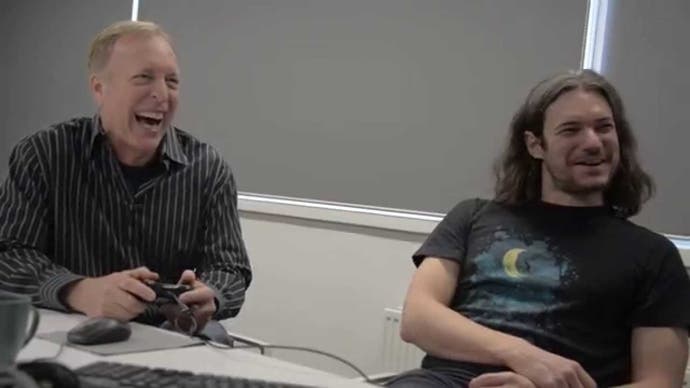
Maybe it helps that the way Raw Thrills works isn't too dissimilar to the set-up at Williams or Atari, with small teams of six to eight people working on each project. The relative success of Raw Thrills' games points to it being an approach that works. "I think it's because we specialise. Some of the huge companies like Sega, Namco, even Capcom and Konami, the arcade hasn't been a real growing area. As a corporation, you realise you should probably take those resources and go to mobile and go to these areas that are growing, and sell people purple cows for 100 dollars, y'know. It's a lot easier money than trying to develop expensive arcade cabinets. We've specialised in this area, and that's helped us. Also we've got nowhere to go! Our backs are against the wall."
It's more than business acumen that has kept Jarvis around, mind. "I just have a love for short-form games that are immediately accessible. I'm kind of ADHD, I don't want to get involved in some huge scenario. It's like Game of Thrones on TV - once you miss three or four you're done. You have to be very faithful and watch 100s of hours to get what's going on. I just want to turn on the TV and do something. I love being able to, at the spur of a moment, just play a game for 5 or 10 minutes. And I like the controls being more ergonomic, for the exact game that you're playing, rather than having a general purpose controller.
"I've always been a fan of visceral experiences. It's more intuitive, you go up and have fun. There have been games where you do a lot of rote memorisation of mazes, remembering arenas and where the special weapons are. Maybe it's because I don't remember stuff very well, but I've always hated games like that where you have to use your conscious mind to memorise things. It becomes work to me. I want to have something where I'm just reacting, like where I'm being chased down by murderers. I'm not thinking, I'm just running for my life. You don't have to think about being in a game..."
Having total control of the player's experience helps break down those barriers and get them into a flow state, and that's another reason Jarvis remains a fan of the arcades, where his craft can extend beyond the screen and to the cabinet around it. I'm reminded of Yu Suzuki's penchant for making games where the cabinet was as integral a part of the experience as the code within - think of taikan cabinets such as the deluxe sit-down versions of Out Run, Space Harrier or AfterBurner - and Jarvis thinks upon similar lines. It's only natural, then, that Raw Thrills is working on a cabinet to complement the console release of Nex Machina.
"You really want to think about the ergonomics, the controls and try to make it as natural as possible. If you ever have to put a message up on the screen, you've failed. You have to make things so intuitive. Some people are very challenged by a 3D simulator. They freak out. Sometimes they don't want to go over the speed limit, when your'e supposed to be driving 160mph down the road and they're doing 55mph. It's not for everyone. It takes a more maniac, breaking the rules kind of personality. You're so confined in life by all these rules, and you want somewhere where you can just break the rules and do crazy stuff. It's kind of a playground.
"Right now we're working on the controls. We're probably going to use twin flight sticks and trigger buttons. We'll probably throw a couple more buttons on there - a couple of thumb buttons - to see how it works out. And we're toying with doing a two-player co-operative, but that's more on the software side. There are camera issues with someone going one way and someone going another."
How large the run of Nex Machina cabinets is remains to be seen, though there's no doubting it'll be entertaining a niche audience. Right now, it seems more likely you'll find one in the barcades that have become more commonplace in recent years than your local multiplex, though there's hope it'll break out that little bit further. "The arcade is a very casual place, and there's a small amount of hardcore players. Here, though, you have these incredible hardcore players.
"They live for this, so it's a completely different thing. Just the essence of this game, with the twin stick control. A lot of people can't do two things at once. I think it's going to be more of a hardcore thing. It's going to be a real test to see if in the arcade you can have a hardcore game. It could suck people in, though, as the original Robotron did, and just kick your ass and you respond to the pain by just giving up and walking away or fighting back and trying to beat it. How many people will walk away and how many people will want to kick ass? That'll be the question."
Housemarque, a developer who by its own admission has struggled in recent years in an increasingly crowded marketplace, will certainly be hoping for a breakout hit, and in its next game all the pieces are in place, helped along with a sprinkling of that Jarvis magic that hasn't dimmed in the slightest over the years. With Nex Machina, Eugene Jarvis is back. The brilliant truth, though, is that he's never really been away.
This article is based on a press trip to Anaheim for the PlayStation Experience. Sony covered travel and accommodation costs.





